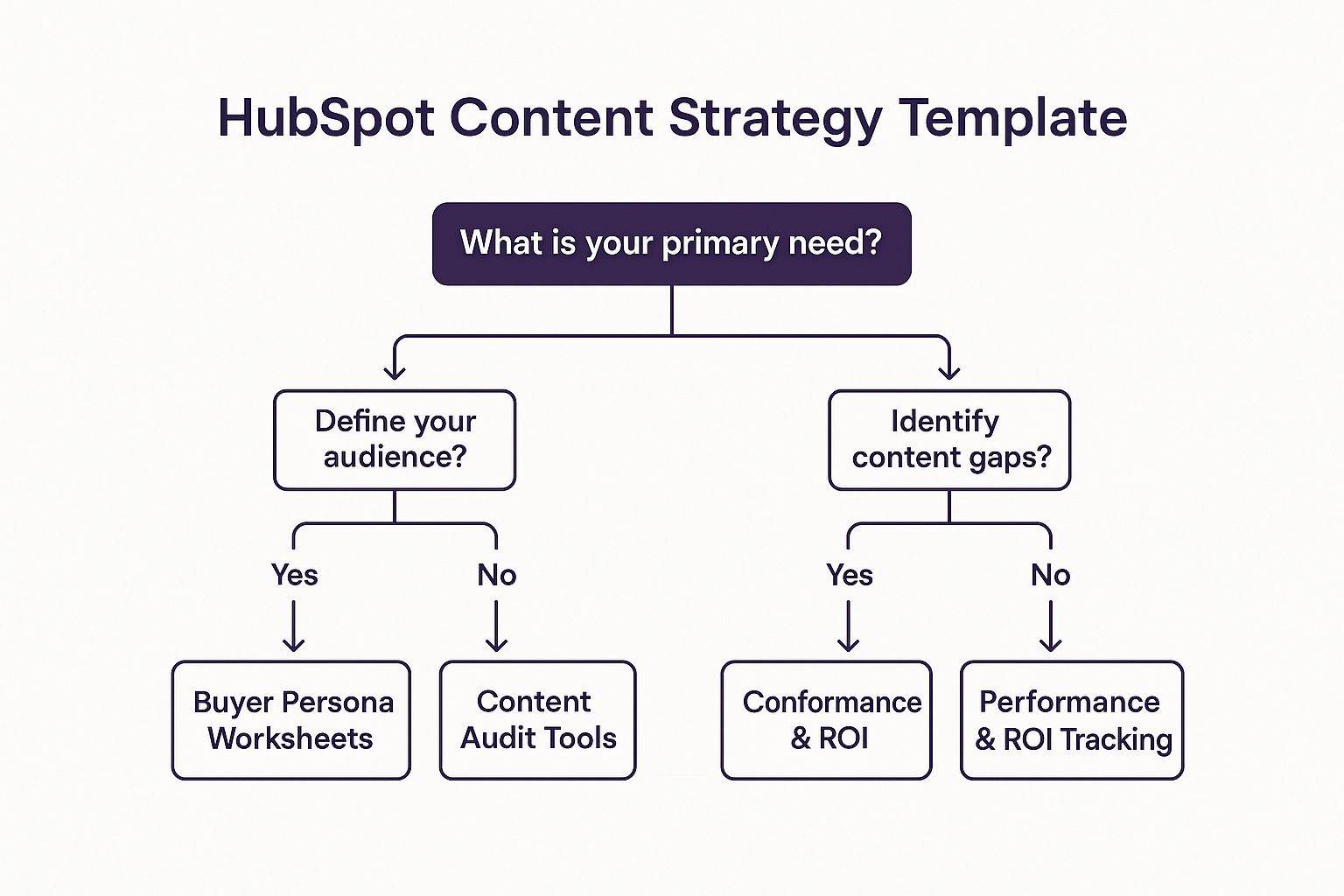Why Your 2025 Marketing Needs More Than Just a Basic Content Strategy Template
To succeed in 2025, your organisation needs more than just a sporadic content schedule. A structured, strategic approach that aligns every article, video, and social media post with clear business objectives is no longer optional, it's essential. A generic, one-size-fits-all plan simply won’t cut it for Brisbane-based businesses or national e-commerce brands aiming for genuine growth. You need a robust content strategy template that acts as a blueprint, guiding your team from initial ideation and creation right through to distribution and performance analysis. This is the foundation for turning content into a predictable revenue-generating engine.
This guide moves beyond surface-level lists to provide a detailed, practical analysis of the top eight content strategy frameworks and templates available today. We’ll dissect each one, covering:
- Core Philosophy: The strategic thinking behind each template.
- Practical Use Cases: How to apply it to real-world scenarios, from local SEO to national campaigns.
- Strengths and Limitations: An honest assessment to help you choose wisely.
Forget guesswork. It's time to build a content system that consistently delivers measurable results. To truly elevate your marketing beyond a basic template, it's also crucial to understand the foundational principles that make any strategy work. Integrating essential content marketing best practices with a powerful framework is the key to maximising your ROI. This resource will provide you with the tools to organise your efforts, engage your target audience effectively, and drive the growth your business deserves.
1. HubSpot Content Strategy Template
HubSpot's offering is less of a single document and more of a complete, integrated system for inbound marketing. This content strategy template is a comprehensive framework built around a core philosophy: attracting customers by creating valuable content and experiences tailored to them. Popularised by inbound marketing pioneers like Brian Halligan and Dharmesh Shah, its strength lies in its deep integration with the buyer's journey, making it a foundational resource for businesses aiming to generate leads and nurture them into customers.
This approach moves beyond simple content planning. It forces a strategic shift towards understanding who your audience is, what problems they face, and how your content can provide solutions at each stage of their decision-making process, from awareness to consideration and finally to decision. For Australian small businesses, this methodology is particularly potent as it builds long-term brand authority and trust, which are crucial for competing in a crowded digital marketplace.
Practical Implementation and Use Cases
The HubSpot framework excels when implemented as a holistic system. Start by deeply developing your buyer personas. The provided worksheets are not just a box-ticking exercise; they are critical tools for building a genuine understanding of your target customers' motivations and pain points. Following this, use the content audit tools to analyse your existing content. This helps you identify what's resonating, what's missing (gaps), and what needs updating, ensuring your efforts are always data-informed.
Real-world success stories underscore its effectiveness. Shopify, for instance, reportedly leveraged HubSpot's inbound principles to achieve a significant increase in blog traffic. Trello's success in generating tens of thousands of monthly leads can also be traced back to applying this buyer-centric content model. These examples highlight that when used correctly, the template isn't just about organising content; it's about building a predictable engine for business growth.
Navigating the HubSpot Toolkit
To help you decide where to begin with this powerful framework, the following decision tree outlines the primary tools within the HubSpot template and their corresponding strategic goals.

This flowchart illustrates that the first step in applying this content strategy template is to clarify your most immediate objective, whether it's defining your audience, optimising existing assets, or measuring your impact.
2. Content Marketing Institute's Strategic Framework
Pioneered by industry leaders like Joe Pulizzi and Robert Rose, the Content Marketing Institute's (CMI) framework is less a fill-in-the-blanks document and more a foundational philosophy. This content strategy template champions an audience-first approach, positing that sustainable business growth comes from becoming a trusted information resource for a specific audience, rather than just pushing products. Its core principle is to create valuable, relevant, and consistent content to attract and retain a clearly defined audience, ultimately driving profitable customer action.
This strategic model compels businesses to think like media publishers. It shifts the focus from campaign-centric marketing to building long-term audience assets. For Brisbane-based SMEs, this is a powerful differentiator. Instead of competing on ad spend, businesses can build authority and loyalty by consistently delivering content that solves their customers' problems, a crucial advantage in the competitive local digital landscape. This framework is about building a relationship with your audience through compelling brand storytelling and measurable business outcomes.

Practical Implementation and Use Cases
Implementing the CMI framework begins with a foundational document: the content marketing mission statement. This isn't just a tagline; it's a strategic guide that defines your core target audience, what you will deliver to them, and what the desired outcome will be for them. Once this is established, every piece of content you create should be measured against it. Following this, significant effort should be put into audience research to ensure your content genuinely meets their needs and is not just based on assumptions.
The power of this approach is evident in major brand successes. Red Bull transformed itself into a media powerhouse by using CMI's principles to create content around extreme sports, not just its energy drink. Similarly, American Express's OPEN Forum became an indispensable resource for small business owners by providing expert advice and insights. These examples demonstrate that by focusing on audience needs first, the framework helps build a loyal following that naturally leads to commercial success. It's about quality and relevance over sheer volume.
Navigating the CMI Toolkit
To help you put this philosophy into action, it's vital to focus on the key pillars of the CMI approach. The following tips outline the primary actions you should take to build your strategy according to CMI's proven methodology.
- Start with a Mission Statement: Before creating any content, clearly define your target audience, the value you will provide, and the desired outcome for the audience.
- Invest in Audience Research: Go beyond basic demographics. Use surveys, interviews, and analytics to deeply understand your audience's challenges and motivations.
- Develop a Consistent Brand Voice: Ensure your tone and style are consistent across all platforms to build brand recognition and trust.
- Create a Governance Document: Align your team by creating a document that outlines roles, processes, and standards for content creation and distribution.
- Focus on Quality Over Quantity: Prioritise creating high-value, cornerstone content that serves your audience's needs over producing a high volume of mediocre assets.
3. GatherContent's Content Strategy Toolkit
Where other templates focus heavily on ideation or measurement, GatherContent’s offering is a content strategy template designed for the messy middle: production and operations. This toolkit centres on creating a repeatable, scalable, and collaborative system for getting content made. Popularised by content operations experts like Rob Mills and Kathleen Warnock, its strength lies in establishing clear workflows, roles, and guidelines, making it an indispensable resource for organisations managing large volumes of content across multiple teams.

This approach brings discipline to the creative process. It forces a strategic shift from ad-hoc content creation to a well-oiled production line, where every piece of content follows a standardised path from brief to publication. For growing Australian businesses, particularly those in e-commerce or professional services, this methodology is crucial for maintaining quality and brand consistency as content demands increase, preventing bottlenecks and ensuring everyone involved understands their part in the process.
Practical Implementation and Use Cases
The GatherContent framework is most effective when used to systematise your entire content lifecycle. Begin by mapping your current content workflow, from the initial idea to the final approval. The provided templates help you formalise this by defining clear stages (e.g., Drafting, Editing, Legal Review, Final Approval). It is vital to clearly define roles and responsibilities at each stage, ensuring accountability and smooth handovers between team members.
This operational focus delivers tangible results. Buffer, for example, successfully scaled its renowned blog by adopting similar structured workflow management for its content team, ensuring consistent output despite a distributed workforce. Likewise, Atlassian utilises comparable frameworks for its extensive documentation, allowing for collaboration between technical writers and product teams. These examples demonstrate that when implemented correctly, this template isn't just about organisation; it's about building a reliable engine for consistent, high-quality content production.
Navigating the GatherContent Toolkit
To get started with this operations-focused framework, it's essential to build a solid foundation based on clear processes and responsibilities. The following tips outline the key steps for implementing the GatherContent methodology to streamline your content creation.
- Map Your Current Workflow: Before implementing any new tool, document every step of your existing content process to identify inefficiencies.
- Define Roles and Responsibilities: Assign clear owners for each stage, from writing and editing to design and publishing, to eliminate confusion.
- Create Standardised Content Briefs: Use a consistent template for every content brief to ensure writers receive all necessary information upfront, improving first-draft quality.
- Build in Review Stages: Incorporate multiple, clearly defined review cycles (e.g., editorial, technical, legal) to guarantee quality and accuracy before publication.
4. CoSchedule's Marketing Calendar Template
CoSchedule's offering champions a unified vision of content and promotion, built on the principle that creation and distribution are two sides of the same coin. This content strategy template is fundamentally an integrated marketing calendar, designed to eliminate the silos that often separate content teams from social media and promotional teams. Popularised by CoSchedule's leadership, including Garrett Moon and Ben Sailer, its power lies in providing a single source of truth for all marketing activities, from initial blog post ideas to the final tweet promoting it.
This approach forces a shift from disjointed activities to a cohesive, campaign-oriented mindset. Instead of planning content in one document and social media in another, teams plan them simultaneously. This ensures that every piece of content is created with its promotion strategy already built-in. For Brisbane-based professional services firms, this organised methodology is invaluable, as it allows for meticulous planning and execution of campaigns, ensuring maximum visibility and lead generation from every asset produced.
Practical Implementation and Use Cases
The CoSchedule framework excels when used as the central hub for all marketing operations. The key is to commit to its integrated nature fully. Start by mapping out your entire marketing workflow within the calendar, using colour-coding to differentiate between blog posts, social campaigns, email newsletters, and events. This visual organisation provides an at-a-glance overview of your entire strategy, making it easy to spot gaps and opportunities.
Real-world success stories demonstrate its value. Global brands like Yamaha Motor have adopted similar integrated calendar systems to coordinate complex, multi-channel product launches. Likewise, Convince & Convert's highly organised content output is a testament to applying this unified approach to marketing. These examples show that when properly implemented, the template isn't just for scheduling; it’s for orchestrating a comprehensive digital marketing strategy that drives measurable results.
Navigating the CoSchedule Framework
To get the most from this template, focus on planning content and its promotion in tandem. The following video from CoSchedule demonstrates how to organise your marketing in one calendar, highlighting the platform's core philosophy of integrated planning.
Watching this will help you understand how to centralise your efforts, ensuring that no piece of content is published without a clear and pre-planned promotional push behind it. This integrated view is the key to unlocking the full potential of your content strategy template.
5. Contently's Brand Journalism Framework
Contently's Brand Journalism Framework repositions content marketing away from direct sales pitches and towards the editorial standards of a newsroom. This content strategy template champions the creation of high-calibre, story-driven content that builds brand authority and fosters genuine audience trust. Pioneered by figures like Joe Coleman and Shane Snow, its core principle is to serve the audience's interests first, believing that commercial success will follow from establishing a reputation for credible, valuable information.
This framework is a philosophical shift, encouraging brands to act like media publishers rather than advertisers. It demands a commitment to journalistic integrity, focusing on storytelling that informs, educates, or entertains without an immediate promotional agenda. For an Australian e-commerce brand or professional services firm, this approach can be a powerful differentiator. It helps to cut through the noise of aggressive advertising by building a loyal readership that values the brand's perspective and expertise, turning passive consumers into an engaged community.
Practical Implementation and Use Cases
Adopting this framework starts with establishing strict editorial guidelines that separate your content from your sales department. This is non-negotiable for maintaining authenticity. The next step is to recruit writers with journalistic or professional writing backgrounds who can find and articulate compelling stories within your industry. Focus on developing long-term content series or thematic pillars, such as in-depth reports or expert interview series, rather than sporadic, disconnected articles. This consistency builds anticipation and solidifies your brand's authority on a topic.
The success of this model is evident in major global brands. American Express's OPEN Forum is a classic example, providing genuine business insights for entrepreneurs without overtly pushing financial products. Similarly, IBM's extensive library of thought leadership content uses journalistic rigour to explore complex technological topics, positioning them as industry leaders. These cases demonstrate that when a brand commits to serving its audience with high-quality, story-driven content, it earns a level of trust and authority that traditional marketing struggles to achieve.
Navigating the Brand Journalism Approach
To help you implement this sophisticated framework, consider the following key pillars that form its foundation. Each pillar represents a critical step in shifting from a promotional mindset to a publisher's mindset.
- Develop Strong Editorial Guidelines: Create a clear charter that defines your publication’s voice, ethical standards, and mission. This document must champion audience value over product promotion and guide every content decision.
- Prioritise Storytelling: Train your team to identify and craft compelling narratives. Focus on human interest, industry trends, and problem-solving stories that resonate emotionally and intellectually with your target audience.
- Maintain Editorial Independence: Establish a "church and state" separation between your content team and sales/marketing teams. The content's primary goal is to build an audience and trust, not to generate immediate leads, which ensures its long-term integrity and effectiveness.
- Build Long-Term Content Series: Move away from one-off blog posts. Instead, plan and execute cohesive content series that allow for deep exploration of topics, building a loyal, returning audience that anticipates your next piece.
6. Neil Patel's SEO-First Content Strategy
Neil Patel's approach is less a single document and more a robust, data-centric philosophy for online dominance. This content strategy template is a framework built on a core principle: every piece of content must be engineered to rank in search engines and attract organic traffic. Popularised by digital marketing authorities like Neil Patel, Brian Dean, and Rand Fishkin, its strength lies in its relentless focus on keyword research, competitor analysis, and on-page optimisation, making it a go-to resource for businesses aiming to build sustainable, long-term traffic streams.
This method forces a strategic departure from simply writing about what you think your audience wants. Instead, it demands a deep dive into what they are actively searching for. It's about reverse-engineering search engine results pages (SERPs) to understand user intent and then creating content that is demonstrably better than what is currently ranking. For Australian businesses, particularly those in competitive markets like Brisbane, this SEO-first methodology provides a clear pathway to gaining visibility and capturing high-intent leads without a reliance on paid advertising.
Practical Implementation and Use Cases
The SEO-first framework excels when implemented with rigorous discipline. The first step is always exhaustive keyword research, using tools to identify high-volume, low-competition terms that your target customers are using. Following this, you must conduct a thorough competitor analysis to see what content is already succeeding for those keywords. Only then do you begin creating content, structuring it around topic clusters to build authority. This involves a primary "pillar" page for a broad topic, supported by multiple "cluster" articles that target more specific, related keywords.
Real-world success stories prove its power. Backlinko's meteoric rise was fuelled almost entirely by Brian Dean's "Skyscraper Technique," an embodiment of this SEO-first model. Similarly, Ahrefs built its brand by creating deeply researched, optimised content that now dominates search results for countless marketing terms. While Neil Patel outlines a broad SEO-first approach, understanding platform-specific optimisation, such as Pinterest SEO best practices, is crucial for maximising reach on visual search engines. For local businesses, implementing a targeted keyword strategy is a foundational element of effective SEO for small business.
Navigating an SEO-First Strategy
To help you get started with this powerful methodology, it's crucial to follow a logical progression of tasks. This approach isn't about guesswork; it's a systematic process designed to maximise your chances of ranking.
The typical workflow involves these key stages:
- Keyword & Competitor Research: Identify what your audience is searching for and analyse the top-ranking content.
- Content Creation & Optimisation: Develop content that is superior to competitors' and optimised for your target keywords and user intent.
- Promotion & Link Building: Actively promote your content to acquire backlinks, a critical ranking factor.
- Performance Monitoring & Refreshing: Track your rankings and traffic, and regularly update your content to keep it relevant and authoritative.
7. Buzzsumo's Social-First Content Framework
Unlike traditional top-down planning, Buzzsumo's approach is an agile, reactive framework built around social media engagement and trending topic analysis. This content strategy template puts social data at the centre of content creation, using real-time insights to engineer virality and drive brand awareness. Popularised by social media analytics pioneers like Steve Rayson and James Blackwell, its power lies in its ability to tap into current conversations, ensuring content is timely, relevant, and highly shareable.
This methodology flips the conventional model on its head. Instead of creating content and then figuring out how to promote it, you first analyse what is already performing well on social media and then create content designed to mirror that success. For Brisbane-based businesses trying to cut through the noise, this social-first approach can be a game-changer. It allows you to align your messaging with topics your audience is actively discussing, fostering genuine engagement and organic reach on platforms where they spend their time.
Practical Implementation and Use Cases
The effective application of Buzzsumo's framework hinges on continuous monitoring and rapid execution. Start by using the platform's Content Analyzer to identify top-performing articles, videos, and infographics in your niche across major social networks. This isn't just about finding popular topics; it's about deconstructing the formats, headlines, and emotional triggers that lead to high share counts. Armed with this data, you can brainstorm content that aligns with these proven success factors while incorporating your unique brand voice.
Real-world examples demonstrate its power. Wendy's audacious Twitter persona and Dollar Shave Club's viral launch video are iconic cases of brands winning by understanding social currency. More tactically, a professional services firm could use Buzzsumo to find the most-shared articles about new financial regulations and then create a more comprehensive LinkedIn post or guide, capitalising on an existing wave of interest. This shows that the framework isn't just about memes; it's a strategic way to achieve visibility and authority. For further insights on professional platforms, you can learn more about using LinkedIn marketing effectively.
Navigating the Social-First Model
To leverage this dynamic framework, you must balance reactive content with core brand messaging. The following guidelines help structure your efforts:
- Monitor Daily: Dedicate time each day to check for emerging trends, keywords, and competitor content that is gaining traction.
- Act Quickly: The window for capitalising on a trending topic is often small. Your team needs to be organised to create and publish content rapidly.
- Balance Your Content: Mix timely, trend-based pieces with evergreen content that reinforces your brand's core value proposition. This ensures long-term stability alongside short-term viral potential.
- Test and Iterate: Continuously experiment with different content types, from short-form video to detailed infographics, to learn what resonates most deeply with your specific audience.
8. Kristina Halvorson's Content Strategy Framework
Kristina Halvorson's framework is less a downloadable file and more a foundational discipline for managing content as a critical business asset. Pioneered by Halvorson and her team at Brain Traffic, this content strategy template champions the idea that successful content requires a sophisticated plan covering its entire lifecycle, from creation to maintenance and eventual archiving. Its core strength is its emphasis on governance and sustainable operations, ensuring content serves both user needs and business goals over the long term.
This approach forces a shift from reactive content creation to proactive, strategic management. It centres on the "content quad," a model that balances substance (what the content is about) and structure (how it's organised) with workflow (processes and people) and governance (policies and standards). For Australian businesses, particularly those with complex digital ecosystems like universities or large e-commerce sites, this methodology provides the rigour needed to prevent content from becoming chaotic, outdated, or misaligned with core objectives.
Practical Implementation and Use Cases
Implementing this framework begins with a thorough content audit to understand your current assets, their performance, and their alignment with strategic goals. A key principle is to involve stakeholders from across the organisation, from legal and marketing to product and customer support. This cross-functional collaboration is vital for developing clear governance policies and a shared understanding of content's role before you attempt to scale your efforts.
Real-world examples demonstrate its power in bringing order to complexity. The Mayo Clinic famously leveraged these principles to build a patient-focused content framework that delivers trusted health information. Similarly, REI’s effective content ecosystem, which seamlessly blends commerce with community, is built on strong governance and a clear understanding of user needs and business objectives. These cases show that the framework isn't just about organising content; it's about building a sustainable, scalable, and effective content operation that underpins the entire digital experience. It ensures every piece of content has a purpose and a plan.
Content Strategy Template Comparison
| Content Strategy Template | Core Features | User Experience & Quality | Value Proposition | Target Audience | Price Point / Access |
|---|---|---|---|---|---|
| HubSpot Content Strategy Template | Buyer personas, content audit, editorial calendar, ROI tracking, SEO guidelines, distribution mapping | Comprehensive reporting, lead gen focused | Free, integrates with HubSpot tools, conversion-driven | B2B, SaaS, inbound marketing | Free |
| Content Marketing Institute's Framework | Audience research, brand storytelling, channel strategy, governance, ROI frameworks, story templates | Strong storytelling, brand focus, measurable | Industry-researched, flexible, long-term brand building | Enterprise, B2B, thought leadership | Typically fee-based/education |
| GatherContent's Content Strategy Toolkit | Workflow & approval, team collaboration, briefs, QA checklists, asset management, timeline tracking | Practical, efficient for teams, quality controls | Scales content ops, strong team coordination | Large content teams, agencies | Varies, likely subscription |
| CoSchedule's Marketing Calendar Template | Editorial + social calendar, campaign planning, promo workflows, team tasks, analytics, content recycling | Visual, easy planning, social media integration | Integrated content & promotion, user-friendly | Small-medium teams, social media managers | Subscription-based likely |
| Contently's Brand Journalism Framework | Editorial guidelines, story ideation, seasonal calendar, engagement metrics, storytelling, freelancer mgmt | High quality, newsroom style, trust-building | Premium brand authority, thought leadership focus | Large enterprises, B2B, premium brands | Premium pricing |
| Neil Patel's SEO-First Content Strategy | Keyword research, competitor analysis, SEO checklists, content clusters, technical SEO, performance tracking | Data-driven, SEO-focused, ranking improvement | Strong organic growth, measurable SEO results | SEO-focused businesses, B2B SaaS | Free resources + paid tools |
| Buzzsumo's Social-First Content Framework | Social trends, viral content patterns, influencer collab, engagement optimization, social listening | Social engagement, virality-driven, data-driven | Boosts brand awareness quickly via social platforms | B2C brands, social media-focused orgs | Subscription-based |
| Kristina Halvorson's Content Strategy | Governance, UX content design, lifecycle mgmt, org alignment, quality guidelines, sustainability | User experience centered, governance strong | Sustainable, comprehensive content ops & alignment | Large orgs, govt, education, digital transformation | Usually consultancy-based |
From Template to Transformation: Activating Your Content Strategy
We've explored a comprehensive array of frameworks, from HubSpot's all-in-one inbound system to Neil Patel's laser-focused SEO approach. Each content strategy template offers a unique pathway to organising your marketing efforts, providing the structural integrity needed to build a powerful and consistent brand presence. The journey, however, doesn't end with choosing a template from a list; that is merely the beginning.
The true value of any template lies not in its rows and columns, but in its ability to be a catalyst for strategic thinking and decisive action. Think of these frameworks as the architectural blueprints for your digital brand. Just as a builder wouldn't follow a single plan for every unique block of land, you shouldn't rigidly adhere to a template that doesn't perfectly suit your business's unique landscape, especially in a competitive market like Brisbane.
Distilling Insights into Action
The most effective content strategy is rarely born from a single source. A Brisbane-based e-commerce brand might find immense value in blending the SEO rigour of Neil Patel's template with the social media insights from Buzzsumo's framework. Similarly, a professional services firm could combine the foundational brand storytelling of the Content Marketing Institute's guide with the practical workflow management offered by CoSchedule's calendar.
Your next steps should be clear and deliberate:
- Conduct a Ruthless Audit: Before you can plan your future, you must honestly assess your past. Use the principles within these templates to analyse your existing content. What has worked? What has failed spectacularly? Where are the gaps?
- Define 'Success' with Precision: Move beyond vague goals like "more traffic". Use the goal-setting sections of these templates to define specific, measurable, achievable, relevant, and time-bound (SMART) objectives. Do you need a 15% increase in qualified leads from organic search in the next quarter? Or are you aiming to boost customer retention by 10% through a targeted email newsletter series?
- Select and Customise Your Toolkit: Choose the content strategy template that most closely aligns with your primary business goals and internal resources. Don't be afraid to pull sections from one and merge them with another to create a hybrid document that is uniquely yours.
Beyond the Core Strategy: Execution is Everything
A well-documented strategy is critical, but execution is what delivers results. Your strategy will inevitably involve various tactical elements, from creating blog posts and videos to managing social media channels and engaging with industry leaders. As you operationalise your plan, you'll need specialised tools for specific tasks. For instance, if your strategy identifies collaborations as a key growth lever, using dedicated influencer outreach templates can streamline your process, ensuring consistent and professional communication that builds valuable partnerships.
Remember, your content strategy is not a static document to be filed away and forgotten. It is a living, breathing guide that should be revisited, refined, and adapted on a regular basis. Market trends shift, customer behaviours evolve, and your business goals will change. A successful strategy is one that is agile enough to adapt to these changes, continually optimised based on performance data and real-world feedback.
Ultimately, a content strategy template is a powerful tool for clarity and focus. It transforms abstract marketing ideas into a tangible plan of action, aligning your team and ensuring every piece of content you create has a purpose. By moving from passive planning to active implementation and continuous refinement, you can turn a simple template into a transformative engine for sustainable business growth.
Feeling overwhelmed by the move from planning to execution? A great strategy is only as powerful as the team implementing it. The experts at CAYD Marketing specialise in transforming content strategies into measurable ROI for Brisbane businesses, handling everything from SEO and PPC to web development and social media management. Partner with us to ensure your content engine drives real, tangible growth.
Article created using Outrank





